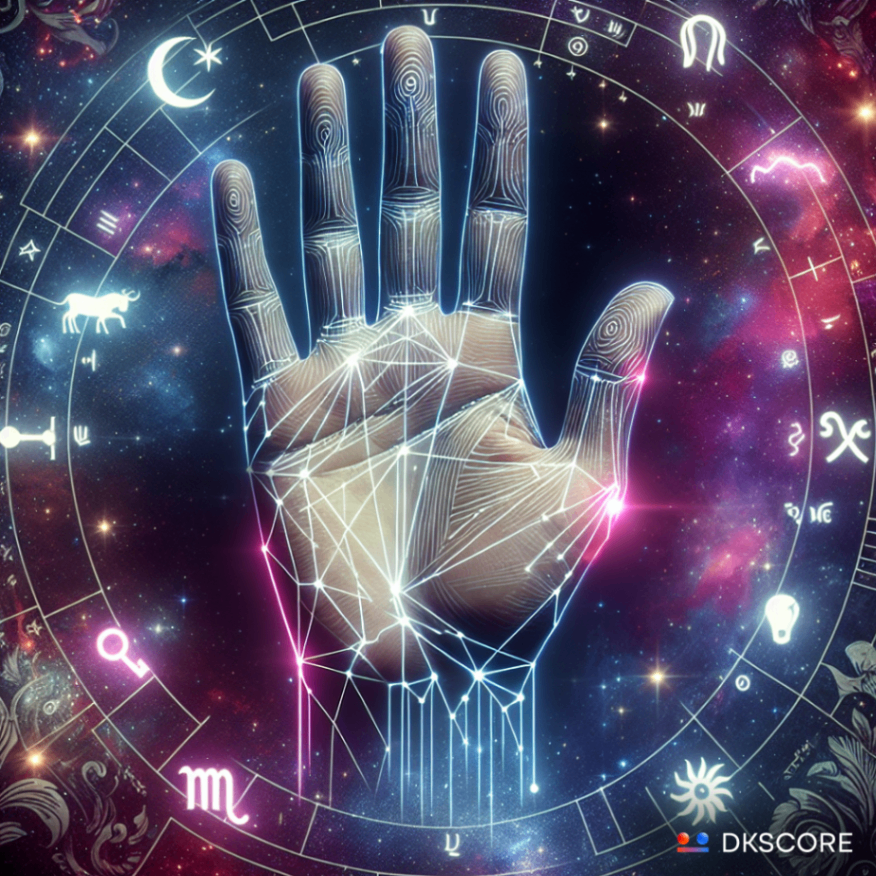Palmistry Reading: Decoding the Future Through Hand Lines

Palmistry, also known as chiromancy, is an ancient practice used to analyze a persons palm and provide insights into their character, potential, and life events. It is deeply intertwined with Vedic astrology, drawing connections between the planets, the mounts on the hand, and various lines to offer detailed predictions. In this guide, we will explore palmistry reading from a Vedic astrology perspective, shedding light on the major and minor lines, mounts, and symbols that reveal your life story.
The Origin of Palmistry in Vedic Astrology
Palmistry has a strong connection to Vedic astrology, with its roots traced back to ancient texts like the Samudrika Shastra. This classic Vedic text outlines the principles of face and hand reading, linking specific planetary energies to different areas of the body. In palmistry, the mounts on the hand represent different planets, while the lines on the palm reflect various aspects of life like love, career, health, and destiny.
Major Lines in Palmistry
Each line on the palm represents a distinct area of life, from health to relationships to professional success. The lifeline, headline, heartline, and fate line are the four primary lines used in palmistry readings.
Lifeline
The lifeline is the most commonly analyzed line in a palmistry reading. Contrary to popular belief, it doesn’t indicate how long you will live but rather reflects your overall quality of life. In Vedic astrology, the lifeline is linked to Mars and vitality. A strong, deep lifeline suggests good health and an active lifestyle, while a broken or weak lifeline may indicate health challenges or significant life changes.
Headline
The headline symbolizes intelligence and decision-making abilities. In Vedic astrology, this line is associated with Mercury, the planet of intellect and communication. A well-defined headline suggests strong mental faculties and problem-solving skills, while a shorter or broken headline can indicate confusion or indecisiveness.
Heartline
The heartline is directly tied to love and emotions. It starts under the little finger and extends across the palm. In Vedic astrology, the heartline corresponds with Venus, the planet of love and relationships. A long, unbroken heartline indicates deep emotional connections and a fulfilling love life. On the other hand, breaks or curves in the heartline suggest emotional turmoil or difficulties in relationships.
Fate Line
The fate line, also called the destiny line, reveals information about one’s career and financial stability. This line is closely related to Saturn in Vedic astrology, representing structure, discipline, and hard work. A prominent fate line indicates a stable career and financial success, while a faded or absent fate line could suggest struggles or uncertainties in professional life.
Additional Lines in Palmistry Reading
Besides the major lines, several minor lines hold special significance. For a deeper analysis, professional palmists look at the Sunline, Mercury line, and Mars line, which provide further insights into personality traits and specific events.
Sunline
The sunline, also known as the Apollo line, represents fame, success, and creativity. It reflects how you gain recognition and wealth through your talents. This line is tied to the Sun in Vedic astrology, which governs status, leadership, and self-expression.
Mercury Line
The Mercury line is connected with communication and business acumen. Its appearance can signify financial success, particularly in fields related to communication, like writing, teaching, or media. As per Vedic astrology, this line is linked with Mercury, the planet that rules communication, trade, and intellect.
Mounts on the Hand and Their Astrological Connections

The mounts on the palm represent different planets and offer another layer of interpretation in palmistry. The strength or weakness of these mounts provides insight into personality, relationships, and destiny.
Mount of Jupiter
Located beneath the index finger, the Mount of Jupiter represents leadership, ambition, and spiritual inclinations. In Vedic astrology, Jupiter symbolizes wisdom and expansion. A well-developed Mount of Jupiter indicates leadership skills, spiritual awareness, and success in fields like teaching and law.
Mount of Saturn
Beneath the middle finger lies the Mount of Saturn, representing discipline, responsibility, and longevity. A strong Mount of Saturn, according to Vedic astrology, shows perseverance, while a flat mount can indicate a lack of structure and struggles with responsibility.
Mount of Sun
The Mount of Sun, located beneath the ring finger, symbolizes creativity and fame. As per Vedic astrology, the Sun governs success and recognition. A well-formed Mount of Sun is an indication of artistic talents and potential for achieving fame.
Mount of Mercury
The Mount of Mercury, found under the little finger, is linked to communication skills and intellect. A strong Mercury mount in palmistry suggests success in business and quick thinking, aligning with Vedic astrology’s interpretation of Mercury as the planet of intellect and commerce.
Mount of Venus
Beneath the thumb, the Mount of Venus represents love, sensuality, and vitality. In Vedic astrology, Venus signifies relationships and pleasures. A prominent Mount of Venus indicates a strong desire for love and harmony, as well as a rich social life.
Hand Types and Their Meanings in Palmistry Reading

Apart from lines and mounts, palmistry reading also involves analyzing the shape of the hand. Hand shapes are categorized into four main types, each reflecting a different elemental influence in Vedic astrology: earth, air, fire, and water.
Earth Hand
Earth hands are broad with square palms and short fingers. People with earth hands are practical and grounded, traits influenced by Mars and Saturn in Vedic astrology.
Air Hand
Air hands have square or rectangular palms and long fingers. These individuals are intellectual and curious, aligning with the traits of Mercury and Rahu in Vedic astrology.
Fire Hand
Fire hands are characterized by square palms and short fingers, representing dynamic, energetic personalities. The influence of Mars and Sun is prominent in these individuals.
Water Hand
Water hands have long palms and long fingers, reflecting emotional depth and creativity. These traits are governed by Moon and Venus, planets connected to feelings and artistry.
Palmistry in Classic Vedic Texts

Classic texts like the Samudrika Shastra extensively cover palmistry in Vedic astrology. According to these texts, the hand reading lines and mounts are direct reflections of planetary positions and their influences on a persons destiny. For instance, Parashara’s Brihat Parashara Hora Shastra provides insights into how planetary placements affect not only the birth chart but also the physical body, including the palms. In essence, palmistry reading offers a way to interpret one’s astrological chart through physical traits.
How to Read Palms: A Step-by-Step Guide
Choose the Correct Hand: For females in India, the left hand is usually analyzed to understand inherent traits, while the right hand reveals current circumstances. For males in India, the opposite applies, with the right hand showing inherent qualities and the left hand indicating the current path.
Analyze the Major Lines: Start by observing the lifeline, headline, and heartline to get an overview of the person’s life, career, and relationships.
Evaluate Minor Lines: Look for the fate line, sunline, and Mercury line to get detailed insights into career success, fame, and communication skills.
Examine Mounts: Assess the mounts for their development to understand which planetary energies are dominant in a person’s life.
Interpret Symbols: Look for triangles, squares, and stars, which can indicate important life events or special talents.
Watch the full video
Conclusion
Palmistry reading, when combined with Vedic astrology, provides a comprehensive understanding of an individuals life, personality, and future. The lines, mounts, and hand shapes each correspond to astrological principles, offering a detailed guide to self-discovery and personal growth. With its rich tradition rooted in ancient texts, palmistry remains an effective tool for interpreting life events and understanding one’s destiny.























